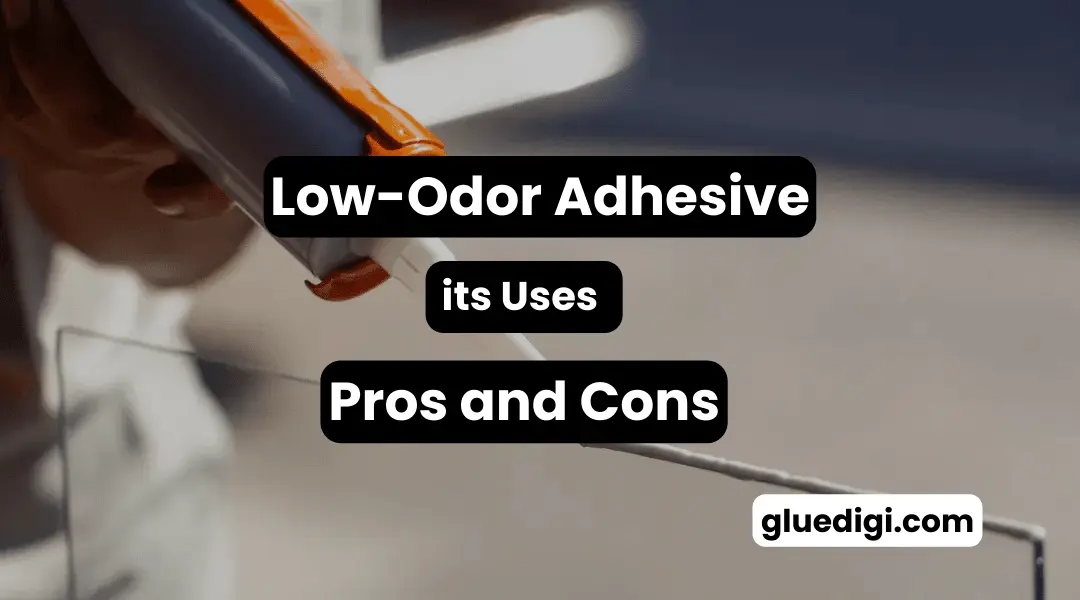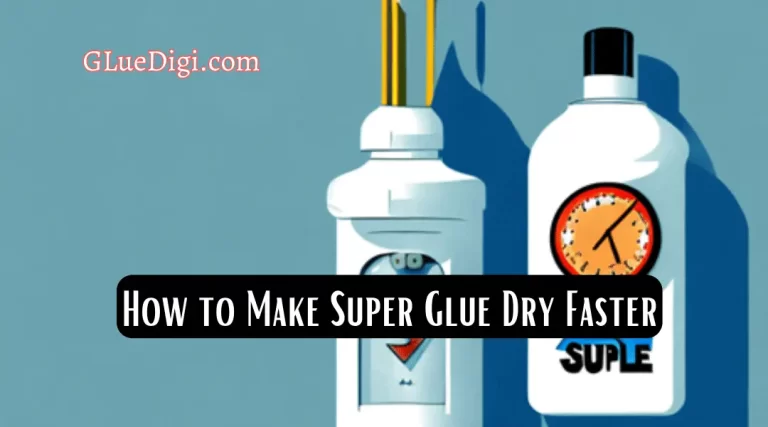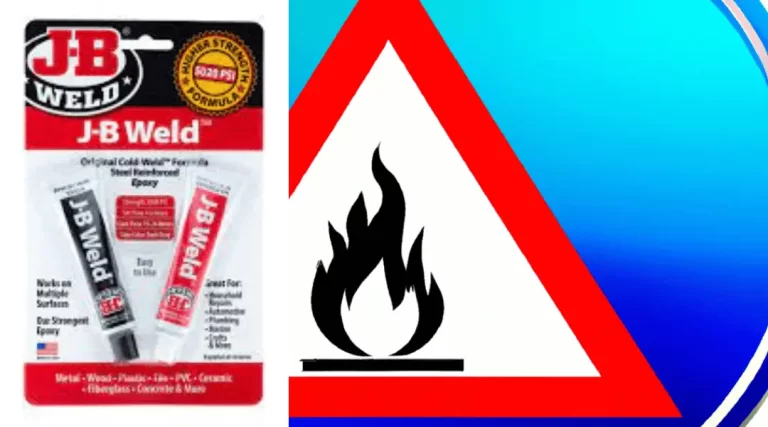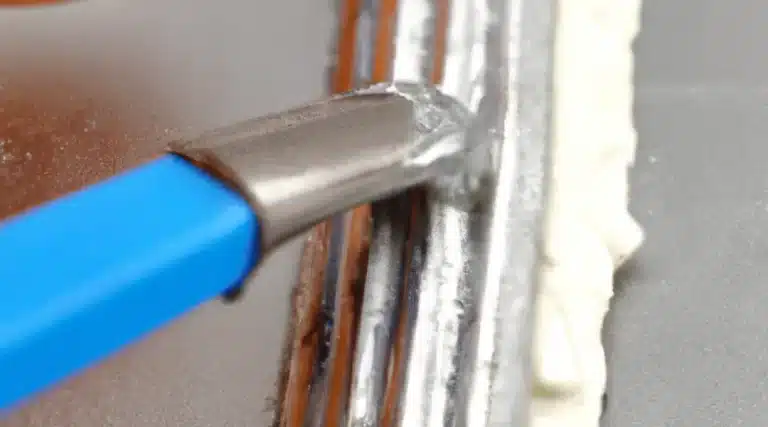Are you looking for low-odor adhesive? Imagine walking into a room filled with the aroma of freshly baked cookies, only to be hit with the unpleasant smell of solid adhesive. It’s like a sudden wind that ruins a perfect summer day.
Such a scenario can be pretty frustrating, especially when you’re in a space where you’re supposed to relax or work. However, low-odor adhesive can be the solution to this problem. Like a gentle breeze, it offers a pleasant and unobtrusive experience that lets you focus on what matters most.
Let’s dive into this peculiar topic and uncover the taste, health risks, and even unique uses of glue beyond its intended purpose.
Low-odor adhesive is a particular type designed to minimize or eliminate the unpleasant smell associated with traditional adhesives. It is a revolutionary product that has recently gained popularity and for good reason.
This adhesive provides a safe and comfortable working environment by reducing the risks of inhaling harmful fumes. In this article, we will look at what low-odor adhesive is, its applications, pros and cons, and how to choose the suitable adhesive for your needs.
Low-order Adhesive and types
Low-odor adhesive is a type of adhesive or glue that emits minimal or no unpleasant or strong odors during its application and curing process.
These adhesives are designed to provide a more pleasant and comfortable user experience, particularly in indoor or enclosed environments where strong odors can be a concern.
They are commonly used in crafting, woodworking, construction, and general household repairs. Here are also some common types of low-odor adhesives:
1. Water-based Adhesive
Water-based adhesives are formulated with water as the primary solvent, resulting in significantly lower VOC emissions compared to solvent-based adhesives.
These adhesives are commonly used in various applications such as paper bonding, packaging, woodworking, and textiles. They offer excellent bonding properties, fast drying times, and easy cleanup.
Water-based adhesives are also favored for their reduced environmental impact and compatibility with a wide range of materials.
2. UV-curable Adhesive
UV-curable adhesives are cured using ultraviolet (UV) light, eliminating the need for traditional solvent-based curing methods. These adhesives have low VOC content, rapid curing times, and high bond strength. They find applications in industries like electronics, optics, and medical devices. UV-curable adhesives offer precise control over curing processes, enabling efficient production and reducing energy consumption.
3. Pressure-sensitive Adhesive (PSA)
Pressure-sensitive adhesives are characterized by their ability to create an immediate bond upon the application of light pressure. These adhesives have low VOC emissions, high tackiness, and excellent removability. PSAs are widely used in labels, tapes, and graphic films. Their low-order characteristics make them a preferred choice for applications where easy repositioning, clean removal, and minimal residue are required.
4. Hot Melt Adhesive
Hot melt adhesives are solid at room temperature and melt upon heating, allowing for easy application. These adhesives have low VOC emissions during the curing process due to the absence of solvents. They offer fast bonding, high heat resistance, and strong adhesion to a variety of substrates. Hot melt adhesives find applications in packaging, woodworking, and automotive industries, providing reliable bonding solutions with minimal environmental impact.
It’s important to note that the specific formulations and availability of low-odor adhesives may vary by brand and manufacturer. Always refer to the product labels and instructions for the most accurate information on a particular adhesive’s odor characteristics and recommended applications.
Understanding Low-Odor Adhesive
The present section aims to provide a comprehensive understanding of the adhesive product that has a reduced emission of volatile organic compounds, making it a popular alternative in industries where the reduction of harmful emissions is a primary concern.

Low-odor adhesive is a type that is free from the firm, unpleasant smell typically associated with traditional adhesives. This is due to its chemical composition, formulated to limit the release of toxic fumes during the bonding process.
As a result, low-odor adhesive is considered a safer and more environmentally friendly option than traditional adhesive methods. Regarding safety, low-odor adhesive is a better choice for workers and consumers alike. The reduction of harmful emissions makes it safer for workers exposed to adhesives in their workplace and consumers who use products that contain low-odor adhesive.
Additionally, low-odor adhesive is more convenient since it does not emit a strong odor that can cause discomfort or trigger allergies. Compared to traditional adhesive methods, low-odor adhesive is a more sustainable option that meets the demands of a conscious market.
Applications of Low-Odor Adhesive
Low-odor adhesive finds extensive applications across various industries and projects where reducing unpleasant smells is essential. Its unique formulation minimizes or eliminates strong odors during and after application, providing a more comfortable and pleasant working environment. From residential renovations to commercial installations, low-odor adhesive is a preferred choice for projects where odor control is a priority.
Furniture Manufacturing and Upholstery
- Low-odor adhesive is widely used in the furniture industry for bonding various materials, including wood, fabric, foam, and leather.
- It ensures a secure and durable bond in the assembly of furniture components, upholstery, and attaching trims without the overwhelming smell associated with traditional adhesives.
Packaging and Labeling
- Low-odor adhesive is an ideal choice for packaging applications, such as carton sealing, box assembly, and label attachment.
- It provides strong adhesion while maintaining a pleasant working environment, making it suitable for food packaging, cosmetics, and other consumer products.
Arts and Crafts
- Low-odor adhesive is popular among artists, crafters, and DIY enthusiasts for various projects.
- It allows for safe and comfortable use during paper crafting, scrapbooking, collage, and other creative applications where odor-sensitive individuals can enjoy the artistic process.
Medical and Healthcare
- Low-odor adhesive finds application in the medical field, where sensitive patients or healthcare professionals may be adversely affected by strong smells.
- It is used in medical device assembly, wound dressings, surgical tapes, and other healthcare applications that require a secure bond without compromising comfort.
Education and Stationery
- Low-odor adhesive is a preferred choice for educational settings, including schools and offices, where a more pleasant working environment is desired.
- It is commonly used for paper projects, school supplies, and stationery applications, providing reliable adhesion without the distracting odor.
Textiles and Apparel
- Low-odor adhesive is employed in the textile and apparel industry for fabric bonding, seam sealing, and attaching embellishments.
- It offers a safe and odor-free solution for applications like garment manufacturing, footwear, and accessories, ensuring comfort and durability.
Automotive Interior
- Low-odor adhesive is utilized in automotive interior applications, such as upholstery, trim attachment, and carpet installation.
- It provides a strong bond without the unpleasant smell, enhancing the comfort and quality of the vehicle interior.
Construction and Renovation
- Low-odor adhesive is valuable in construction projects that require bonding materials like tiles, flooring, wall coverings, and paneling.
- It offers a safe and efficient alternative, ensuring a reliable bond while reducing the exposure to strong odors during construction or renovation activities.
Pros of Low-Odor Adhesive
Low-odor adhesive offers several advantages over traditional adhesives, making it a popular choice in various industries. One of its main benefits is its versatility, which can be used on multiple surfaces and materials.
1. Safer Work Environment
Low-odor adhesive reduces health risks by minimizing the release of toxic fumes, ensuring a safer environment for workers who are exposed to adhesives in their workplace.
2. Improved Indoor Air Quality
By limiting the emission of strong odors and volatile organic compounds (VOCs), low-odor adhesive helps improve indoor air quality, creating a healthier and more comfortable living or working space.
3. Enhanced User Experience
The absence of a strong, unpleasant smell in low-odor adhesive makes it more pleasant to work with, providing a better user experience for both professionals and consumers.
4. Reduced Allergenic Potential
Low-odor adhesive lowers the risk of triggering allergies or sensitivities, making it a suitable choice for individuals who are sensitive to strong odors or have respiratory sensitivities.
5. Environmentally Friendly
With its reduced emission of harmful fumes, low-odor adhesive contributes to a greener and more sustainable environment, aligning with eco-conscious practices and regulations.
6. Wide Range of Applications
Low-odor adhesive offers versatility and compatibility with various materials, making it suitable for a wide range of applications, from crafts and DIY projects to industrial manufacturing.
7. Faster Turnaround Time
The lack of strong odors in low-odor adhesive allows for quicker ventilation, reducing the waiting time required for the adhesive to cure or dry.
8. Improved Aesthetics
Low-odor adhesive ensures that the finished product or project maintains its original appearance without the intrusion of unpleasant odors that can affect the overall aesthetics.
9. Compliance with Regulations
Using low-odor adhesive ensures compliance with strict regulations and guidelines regarding VOC emissions, demonstrating a commitment to environmental and safety standards.
10. Suitable for Indoor Applications
Low-odor adhesive is ideal for indoor projects, as it minimizes odors that can linger in enclosed spaces, such as homes, offices, schools, and healthcare facilities.
11. Reduced Disruption
The absence of strong odors in low-odor adhesive minimizes disruption to daily activities or occupants during installation, allowing for a more seamless workflow.
12. Convenience and Ease of Use
Low-odor adhesive is user-friendly and can be applied using standard application methods, providing convenience and ease of use for professionals and DIY enthusiasts.
13. Long-Term Odor Control
By using low-odor adhesive, the risk of long-term odors or lingering smells in the finished project is significantly reduced, enhancing the overall satisfaction and longevity of the application.
Note: Low-odor adhesive offers numerous advantages, including a safer work environment, improved indoor air quality, enhanced user experience, and compliance with regulations. Its versatility, convenience, and reduced disruption make it a preferred choice for various applications, while its environmentally friendly nature contributes to a sustainable future.
Cons of Low-Odor Adhesive
Potential Longer Curing Time
In some cases, low-odor adhesive formulations may have a longer curing time compared to traditional adhesives. This can extend the overall project duration, especially when immediate bond strength is required. It is important to consider the specific curing characteristics of the chosen low-odor adhesive and plan accordingly to accommodate any additional curing time.
Limited Availability and Options
While the popularity of low-odor adhesives is increasing, the range of available options and formulations may be more limited compared to traditional adhesives.
Certain specialized applications or specific material requirements may have fewer choices when it comes to low-odor adhesive products. It is essential to ensure that the desired low-odor adhesive is suitable for the intended application and meets the necessary performance criteria.
Potential Higher Cost
Low-odor adhesive formulations often involve more advanced technologies and environmentally friendly components, which can result in a higher cost compared to traditional adhesives.
The use of specialized raw materials and production processes contributes to the elevated price point of low-odor adhesives. It is important to consider the project budget and evaluate the cost-benefit ratio when opting for low-odor adhesive solutions.
Adhesion Strength and Durability
While low-odor adhesives offer many advantages, some formulations may have slightly lower adhesion strength and durability compared to certain traditional adhesive options. It is crucial to select a low-odor adhesive that meets the specific bonding requirements of the application.
Conducting thorough testing or consulting with adhesive specialists can help ensure that the chosen low-odor adhesive will provide the necessary strength and longevity for the intended use.
Environmental Sensitivity:
Although low-odor adhesives are designed to reduce the emission of harmful substances, their disposal and environmental impact should still be considered. Proper waste management and also adherence to local regulations are crucial to minimize any potential negative effects on the environment.
Additionally, the use of low-odor adhesive should not be seen as a standalone solution for environmental sustainability. Adopting a holistic approach, including reducing waste and promoting recycling, is important for overall eco-conscious practices.
Things to Consider While Choosing the Right Adhesive
Selecting the appropriate adhesive for a specific application requires careful consideration of several factors. By understanding these key aspects, you can make an informed decision and ensure a successful bonding process.
1. Substrate Compatibility
Select an adhesive that is compatible with the materials you are bonding. Consider factors such as surface porosity, texture, and chemical composition to ensure optimal adhesion.
2. Bond Strength Requirements
Determine the level of strength required for your application. Different adhesives offer varying levels of bond strength, ranging from temporary to permanent bonds, depending on your specific needs.
3. Environmental Conditions
Consider the environmental conditions the adhesive will be exposed to, such as temperature, humidity, and exposure to chemicals or UV light. Choose an adhesive that can withstand these conditions without compromising its performance.
4. Cure Time
Evaluate the desired curing or drying time. Some adhesives offer fast curing for quick results, while others may require longer curing times for optimal bonding strength.
5. Application Method
Consider the application method that suits your project. Adhesives come in various forms such as liquids, pastes, tapes, or films. Choose the appropriate form based on the application requirements and also ease of use.
6. Health and Safety Considerations
Take into account any health and also safety considerations. Consider adhesives with low VOC emissions, low odor, or those that comply with specific regulations to ensure the well-being of users and environmental sustainability.
7. Flexibility and Durability
Evaluate the flexibility and durability requirements of your application. Certain adhesives offer flexibility to accommodate movement or vibrations, while others provide high resistance to impact, moisture, or aging.
8. Ease of Cleanup
Also Consider the ease of cleanup after application. Some adhesives are solvent-based and may require special cleaning procedures, while others, such as water-based or pressure-sensitive adhesives, offer easier cleanup options.
9. Longevity and Aging
Assess the longevity and also aging characteristics of the adhesive. Determine if it can maintain its bond strength over time without deteriorating or losing adhesion properties, especially for long-term applications.
10. Cost-Effectiveness
Evaluate the cost-effectiveness of the adhesive. Consider factors such as the volume of adhesive required, shelf life, and overall value for the desired performance. Compare different options to find the best balance between quality and cost.
Conclusion
Low-odor adhesive is a type of adhesive that is formulated to emit minimal or no smell. It is commonly used in settings where strong odors can cause discomfort or health problems, such as in hospitals, schools, and offices. This type of adhesive is also preferred by people who have sensitive noses or are allergic to certain chemicals.
As the saying goes, ‘Where there’s smoke, there’s fire.’ Similarly, where there’s a strong odor, there may be harmful chemicals or substances present. By choosing low-odor adhesive, you are not only creating a more pleasant work environment but also reducing the risk of exposure to harmful chemicals.





